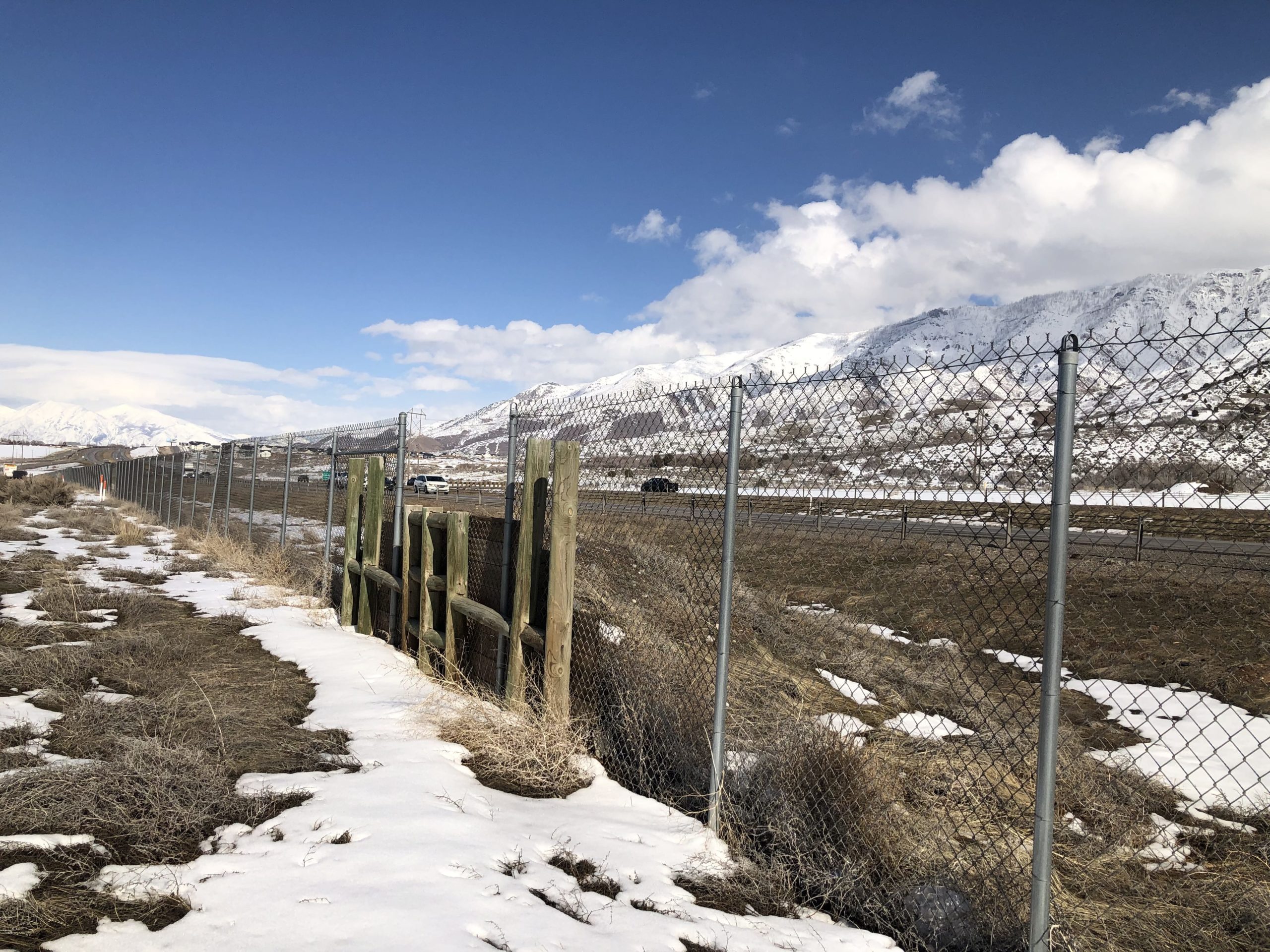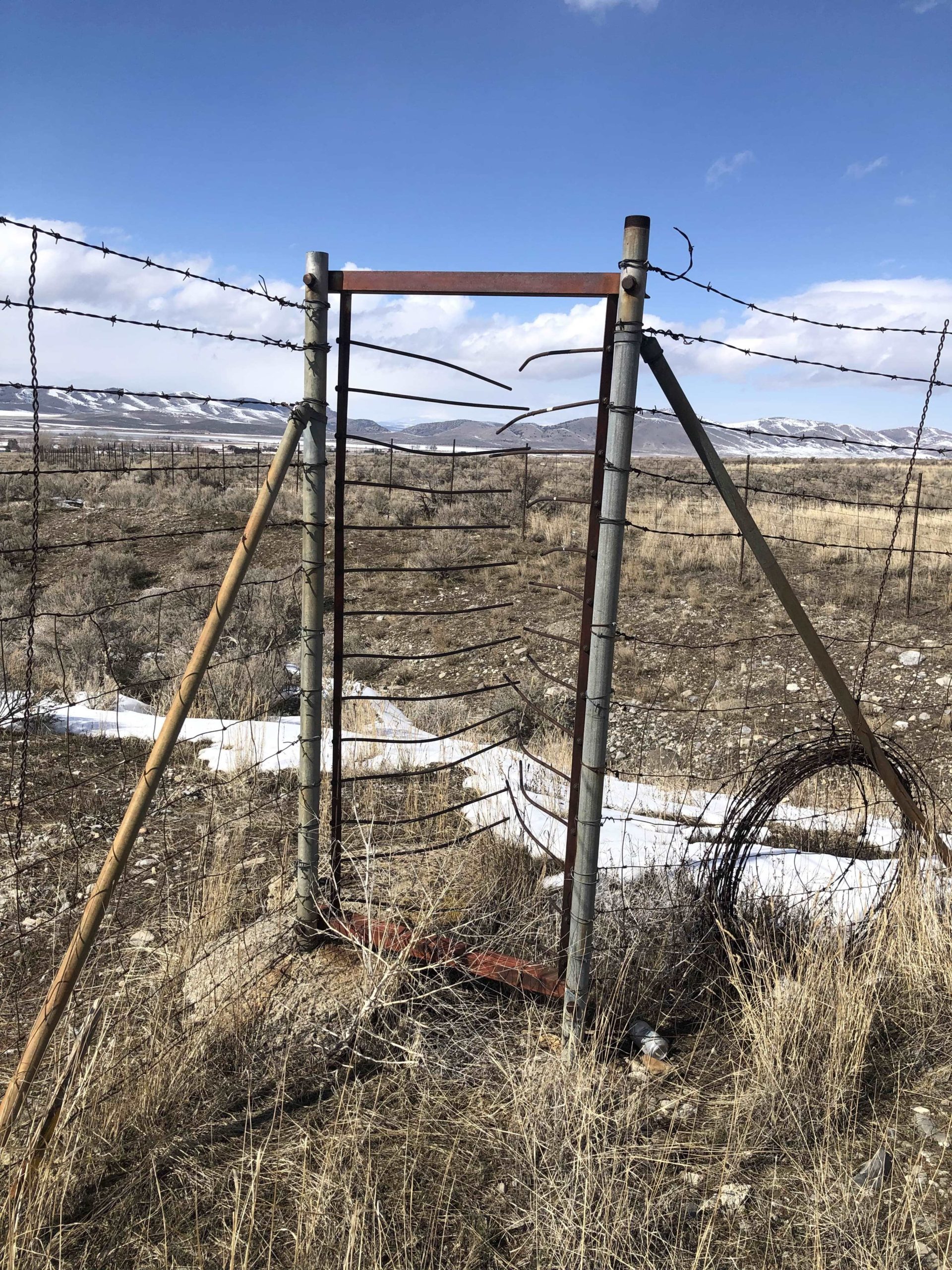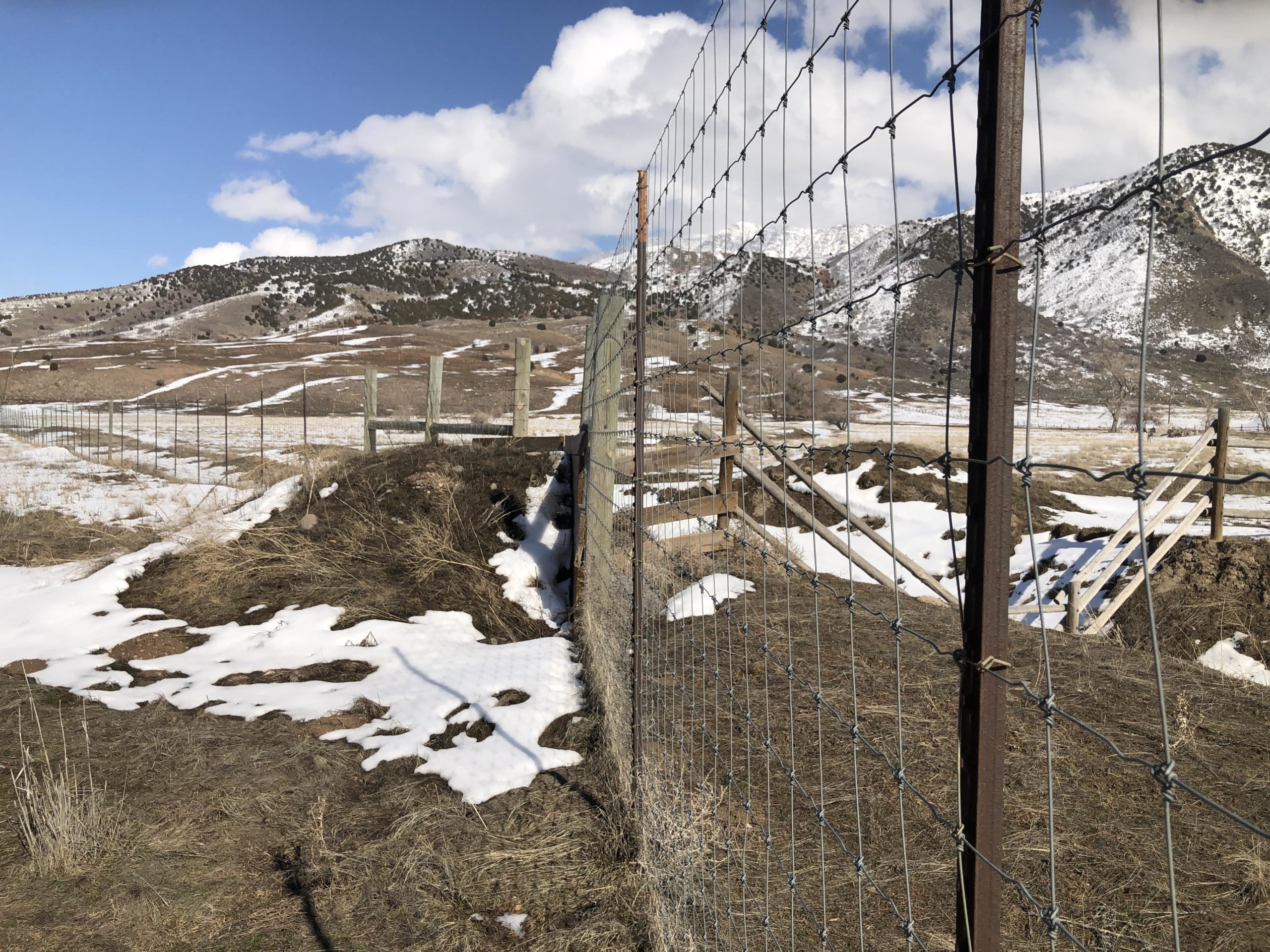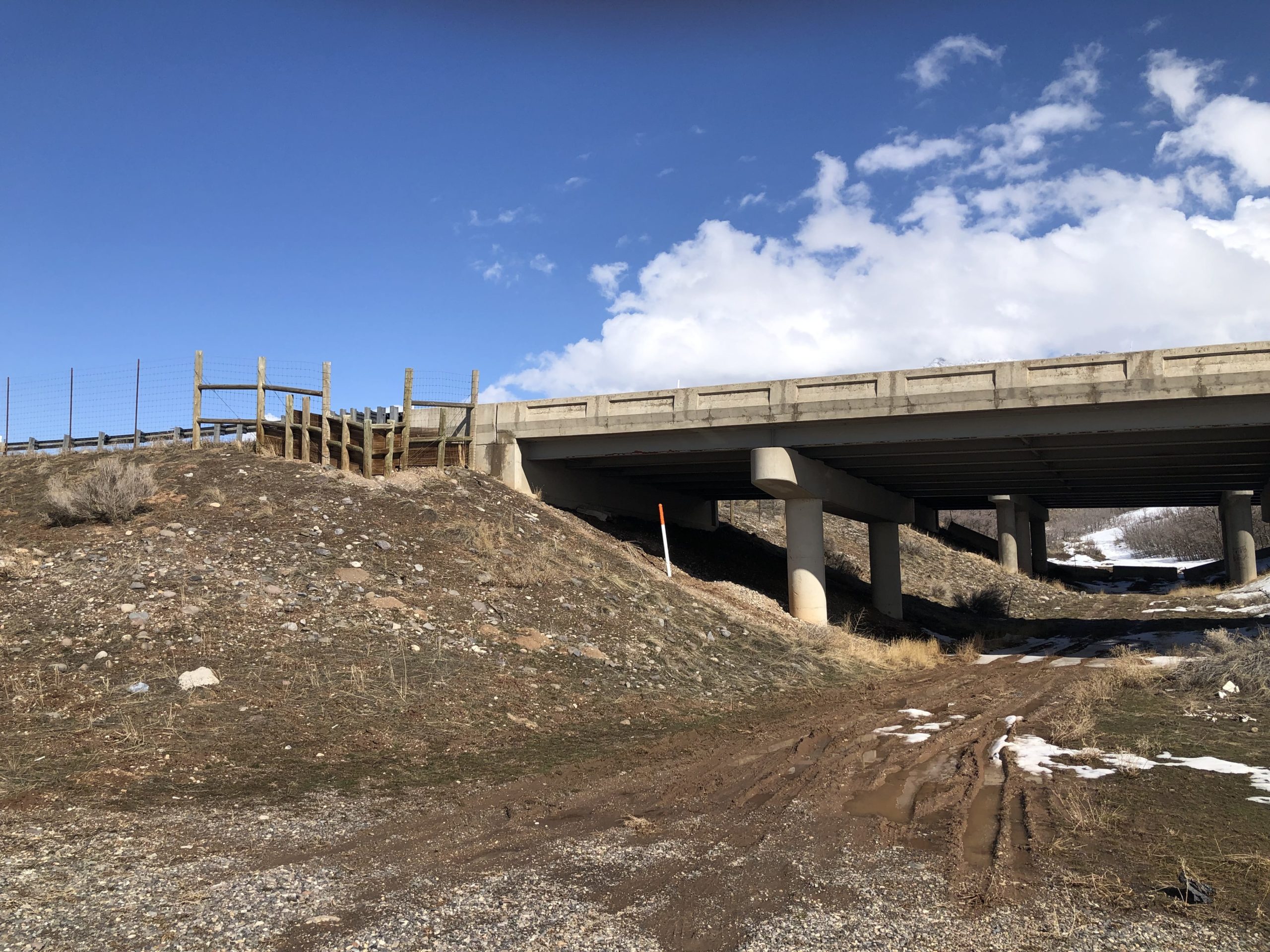
Near Santaquin, UT
Courtesy & Copyright Lyle Bingham, Photographer
 Safety Side, Corner Escape Ramp
Safety Side, Corner Escape Ramp
Near Santaquin WMA
Courtesy & Copyright Lyle Bingham, Photographer
 One-way, Metal Gate
One-way, Metal Gate
Near Santaquin WMA
Courtesy & Copyright Lyle Bingham, Photographer
 Climbing Side, Corner Escape Ramp
Climbing Side, Corner Escape Ramp
Near Santaquin WMA
Courtesy & Copyright Lyle Bingham, Photographer
 Underpass and Jump Ramp
Underpass and Jump Ramp
Near Santaquin WMA
Courtesy & Copyright Lyle Bingham, Photographer
 Rural Road Leading to Santaquin
Rural Road Leading to Santaquin
Wildlife Management Area
Courtesy & Copyright Lyle Bingham, PhotographerDeer and other wildlife have been migrating across our state much longer than humans. When people drove horse-drawn wagons and slower vehicles, wildlife could easily pass without a problem. However, with the introduction of fenced highways and their increased speed and traffic, problems quickly arose. In this case, the problem is mostly with mule deer, because they comprise 90% of the animals migrating in Utah. Robert Frost wrote that “Good fences make good neighbors.” But neighbors need to cooperate to maintain a fence, and even with fences in place, what if the neighbors are animals? The problem is how to keep migrating deer from jumping fences and causing accidents.
Animal/vehicle encounters cause over 5,000 animal deaths in Utah each year. Beyond the loss of life, it is also an economic problem, not only for wildlife management but also for vehicle owners. Some estimate the deer are worth more than $2,500 each. Joshua Coursey wrote in the Deseret News, that the “estimated cost of collisions with mule deer in Utah reached close to $50 million in 2021.” That’s why the Utah Department of Transportation (UDOT) and the Division of Wildlife Resources (DWR) have worked for decades to reduce wildlife/vehicle encounters. As noted, fencing alone does not work; consequently, highway managers have had to find ways to get trapped deer across and away from fenced roads.
When USU researchers studied escape mechanisms in Sardine canyon, they found earthen escape mounds were superior to one-way, metal gates. Climbing a hill is more natural to deer than pushing through a metal gate. These mounds enable a one-way jump to safety. However, escape alone does not solve the driving force of migration.
A more effective way to handle migrating animals is to guide them above or below the road. UDOT explains: “Studies have shown there is a 90% reduction in wildlife/vehicle collisions when there is a crossing structure and fence in the area.” Since 1975, when UDOT built its first wildlife overpass near Beaver, Utah, deer, moose and elk, along with bear and mountain lions have begun to use wildlife underpasses and overpasses. More recently, a larger overpass was built in Parley’s Canyon on I-80. Videos show a variety of animals who successfully traverse that overpass.
But escape ramps and overpasses aren’t the only tools available. Passage is also possible using creek beds or culverts crossing under roads. Tall fences are effective in guiding animals toward structures and preventing roadway access. Then, to encourage faster adoption, contractors have found they can walk a herd of cattle through the structure, overpowering human scents
When on I-15, I-80, I-70, or in our canyons, watch for overpasses, underpasses, one-way gates and exit ramps. They demonstrate a few ways the DWR and UDOT are working together to preserve human and animal lives.
This is Lyle Bingham, and I’m Wild About Utah and our 15 years on Utah Public Radio.
Credits:
Videos: Utah Division of Wildlife Resources https://wildlife.utah.gov
Photos: Courtesy & Copyright Lyle Bingham, Photographer
Featured Audio: Courtesy & Copyright © Friend Weller, Utah Public Radio upr.org
Text: Lyle Bingham, https://bridgerlandaudubon.org/
Additional Reading: Lyle Bingham, https://bridgerlandaudubon.org/
Additional Reading
Wild About Utah, Lyle Bingham’ Wild About Utah Postings
USU-Connected Researchers Mitigating Wildlife Migration Issues:
John Bissonette, Patricia Cramer and Mary Hammer
Bissonette, J. A. and M. Hammer. 2000. Effectiveness or earthen return ramps in reducing big game highway mortality in Utah. UTCFWRU Report Series 2000 (1): 1-29.https://escholarship.org/content/qt2f1080nm/qt2f1080nm.pdf
Buford, Daniel, Cramer, Patricia, and Simpson, Nova, Integrating Wildlife Connectivity and Safety Concerns into Transportation Planning Processes, Federal Highway Administration, US Department of Transportation, Winter 2023, https://highways.dot.gov/public-roads/winter-2023/04
Wildlife Connectivity Institute, https://www.wildlifeconnectivity.org/
“A dynamic part of a National Cooperative Highway Research Program sponsored research project titled; ‘Evaluation of the Use and Effectiveness of Wildlife Crossings.'”, https://www.wildlifeandroads.org/
Muffoletto, Mary-Ann, USU Ecologist [Patricia Cramer] Honored for Wildlife Highway Crossing Research, Utah State Today, Utah State University, April 16, 2015, https://www.usu.edu/today/story/usu-ecologist-honored-for-wildlife-highway-crossing-research
Muffoletto, Mary-Ann, USU Ecologist Leading Efforts to Stop Wildlife-Vehicle Collisions, Utah State Today, Utah State University, September 2, 2010, https://www.usu.edu/today/story/usu-ecologist-leading-efforts-to-stop-wildlife-vehicle-collisions
DWR: “It’s the video seen around the world! This compilation of footage shows various animals using the wildlife crossing constructed in 2018 over Interstate 80 near Parleys Summit. What’s especially notable with this crossing is how many animals are already using it; usually it takes several years for wildlife crossings to become widely used.
This video went viral near the end of 2020, and was celebrated as great progress in the problem of wildlife-vehicle collisions. Special thanks to the Utah Division of Wildlife Resources, Utah Department of Transportation and Summit County for the footage.” https://wildlifemigration.utah.gov/stories/parleys-summit-wildlife-crossing/
UDOT: Baker Canyon Wildlife Crossing Installation
DWR: “Utah’s highways are vital to the health of the state. They can present a significant barrier for wildlife migration. In order to prevent automobile/wildlife collisions and to increase habitat availability for animals, Wildlife biologists and the Utah Department of Transportation have designed and installed several overpasses and underpasses to allow wild animals to safely cross the highway.”
Green, Ashley, Highway wildlife crossings, Connections between habitats are important for wildlife. Wildlife Blog, Utah Division of Wildlife Resources, Utah Department of Natural Resources, https://wildlife.utah.gov/news/wildlife-blog/675-highway-wildlife-crossings.html
Kenley Fry, Rachel, Safe passage: Sardine Canyon wildlife crossings improved, The Herald Journal, October 21, 2012 Updated May 4, 2015 https://www.hjnews.com/allaccess/safe-passage-sardine-canyon-wildlife-crossings-improved/article_2d38f7f4-1b1d-11e2-a588-0019bb2963f4.html
Mapping Migration Corridors, Wildlife Migration, Utah Wildlife Migration Initiative, Division of Wildlife Resources, Department of Natural Resources, State of Utah, https://wildlifemigration.utah.gov/land-animals/corridors/
